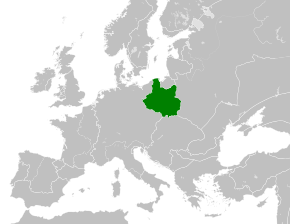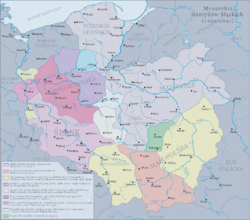Place:Duchy of Poland (1138–1227)
Duchy of Poland | |
|---|---|
| 1138–1227 | |
 Poland within Europe in 1190. | |
| Capital | Kraków |
| Official languages | Polish Latin |
| Religion | Roman Catholicism (institutional) Slavic paganism (practiced) |
| Demonym(s) | Polish |
| Government | Confederal agnatic seniority monarchy (1138–1180) Confederal monarchy (1180–1227) |
| High Duke | |
• 1138–1146 (first) | Władysław II the Exile |
• 1225–1227 (last) | Leszek the White |
| Historical era | Middle Ages |
• Fragmentation of the state | 1138 |
• End of the agnatic seniority succession rule | 1180 |
• Abolishment of the High Duke title | 1227 |
| Currency | Denar |
| ISO 3166 code | PL |
The Duchy of Poland[lower-alpha 1] was a confederal duchy in Central Europe consisted of various states under the rule of the High Duke, an office bared by the ruler of the Seniorate Province until 1227. The state was reformed from the Duchy of Poland in 1138 following the fragmentation of the country into the confederation, after the death of Bolesław III Wrymouth. In 1227, the title of High Duke, and the confederal state, got abolished, with the following duchies gaining independence: Kraków, Masovia, Kuyavia, Łęczyca, Sieradz, Dobrzyń, Gdańsk and Świecie and Lubiszewo, Sandomierz, Poznań, Gniezno and Kalisz.
In 1138, the state was divided into the following district principalities: Seniorate Province, Greater Poland, Sandomierz, Masovia and Silesia. It additionally held control over the Duchy of Pomerelia. Later on, the state also consisted of the duchies of Czersk, Płock, Poznań, Gniezno, Kalisz, Kuyavia, Łęczyca, Sieradz, Brześć Kujawski, Inowrocław, Dobrzyń and Wiślica.
History
Before he died, Bolesław III Wrymouth divided the country, in a limited sense, among four of his sons. He made complex arrangements intended to prevent fratricidal warfare and preserve the Polish state's formal unity, but after Bolesław's death, the implementation of the plan failed and a long period of fragmentation was ushered in. For nearly two centuries, the Piasts would spar with each other, the clergy, and the nobility for the control over the divided kingdom. The stability of the system was supposedly assured by the institution of the senior or high duke of Poland, based in Kraków and assigned to the special Seniorate Province that was not to be subdivided. Following his concept of seniorate, Bolesław divided the country into five principalities: Silesia, Greater Poland, Masovia, Sandomierz and Kraków. The first four provinces were given to his four sons, who became independent rulers. The fifth province, the Seniorate Province of Kraków, was to be added to the senior among the princes who, as the Grand Duke of Kraków, was the representative of the whole of Poland. This principle broke down already within the generation of Bolesław III's sons, when Władysław II the Exile, Bolesław IV the Curly, Mieszko III the Old and Casimir II the Just fought for power and territory in Poland, and in particular over the throne of Kraków.[1]
List of rulers
High Dukes
- Władysław II the Exile (1138–1146)
- Bolesław IV the Curly (1146–1173)
- Mieszko III the Old (1173–1177)
- Casimir II the Just (1191–1194)
- Leszek the White (1194–1198)
- Mieszko III the Old (1198–1199)
- Leszek the White (1199)
- Mieszko III the Old (1199–1202)
- Władysław III Spindleshanks (1202–1206/1210)
- Leszek the White (1206/1210–1210)
- Mieszko IV Tanglefoot (1210–1211)
- Leszek the White (1211–1225)
- Henry the Bearded (1225)
- Leszek the White (1225–1227)
Notes
References
- ↑ Jerzy Wyrozumski, Historia Polski do roku 1505, pp. 104–111
Bibliography
- Dybkowska A., Żaryn J., Żaryn M., Polskie dzieje. Od czasów najdawniejszych po współczesność, wyd. 2, Warsaw 1995. ISBN 83-01-11870-9.
- Morby J.E., Dynastie świata. Przewodnik chronologiczny i genealogiczny, Kraków 1995, s. 261–263. ISBN 83-7006-263-6.
- Wyrozumski J., Dzieje Polski piastowskiej (VIII w.-1370), Kraków: Fogra, 1999, ISBN 83-85719-38-5, OCLC 749221743.
- Zientara B., Henryk Brodaty i jego czasy, wyd. 2, Warszawa 1997.


